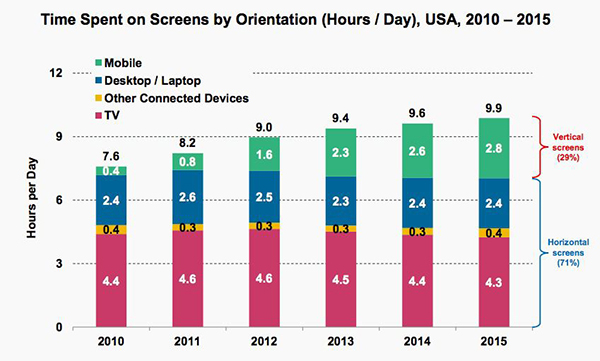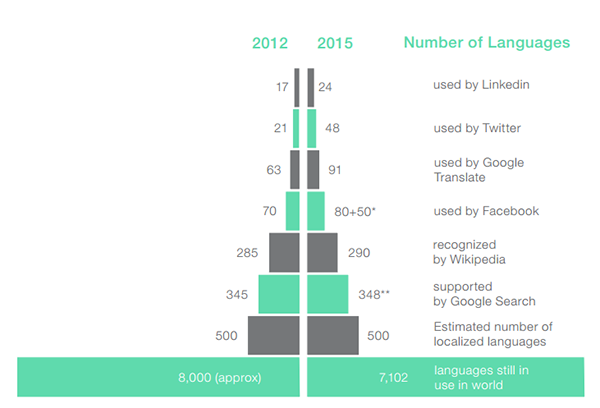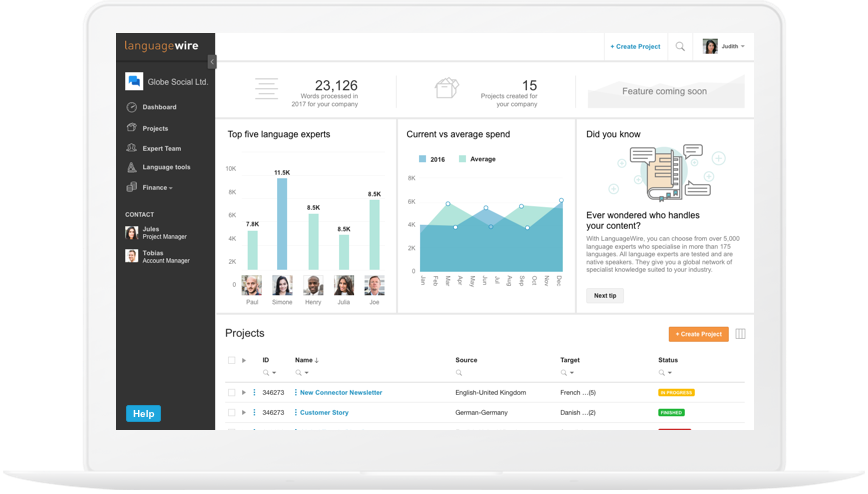Becoming one of the world’s top language service providers isn’t easy. Doing so requires a broad offering of services, great people, the best technology and the ability to successfully navigate industry trends. In this post, we’ll share some of our knowledge to help you improve your own performance when creating multilingual content and stand out from the crowd. Read on to find out what’s currently happening in the language services market and what will influence it in the coming years.
Multilingual content boom
First up, we’ll take a look at one of the more obvious trends affecting translations. Content creation and the demand for multilingual content is increasing and will continue to explode over the next few years. Here are some of the factors behind the multilingual content boom.
Customer experience
Brands’ ability to create valuable content and improve customer experiences will grow and lead to the production of more high quality content in multiple languages. There will be a movement along the hype cycle from the time that technologies that improve customer experiences are available, to marketing teams actually utilising them en masse.
Demonstrating how important the customer experience has become, Gartner states that "by 2017, 89% of marketers expect customer experience to be their primary differentiator”. This shift is reflected in the way that many traditional software providers now focus on the “experience”. For example, Sitecore has the Sitecore Experience Platform, Episerver the Digital Experience Cloud, Drupal the Digital Experience Platform and Adobe has an Experience Manager. So let’s take a look at the evolution of Sitecore. It first started out as the Online Marketing Suite (OMS) that then became the Digital Marketing System (DMS). It was later merged with their Content Management System (CMS) under the Customer Engagement Platform (CEP), and this eventually became the Customer Experience Platform (CXP) that’s in use today.
A more customer centric approach to business has also lead to the rise of the omnichannel marketing approach. The goal here is to provide the customer with one coherent and meaningful experience, regardless which channels they choose when interacting with a brand. As you can imagine, this requires more content than ever before as you need to provide the right message to the right customer situation. You can read more about omnichannel in our article series about omnichannel marketing.
Screen Swarm
The proliferation of devices for sharing and consuming content will increase the demand for multilingual content. Yes, in 2017 and beyond there will be an even greater variety of screens, and people will somehow spend even more time looking at them. To demonstrate how quickly device trends can change, just look at the iPad. It was first released on April 3, 2010, which is not at all long ago. Since then, it has both become ubiquitous and then lost a lot of its popularity.

Source: Internet Trends 2015, Mary Meeker, KPCB
Brands compete for attention on all of these screens by creating entertaining and informative marketing content and product information. This material is easier to produce and disseminate than in the past, but the flood of information the consumer faces makes it hard for the brands to stand out. Speaking the language of the local audience greatly improves the chances of being noticed. Common Sense Advisory (CSA) recently conducted a study of consumers from countries where English isn’t the native language, and found that over half of their 3,002 respondents rarely or never do their online shopping from English-language sites.
The government, man
New government regulations and initiatives will increasingly create a demand for translation and localisation. Take this recent example of the Korean government cooking up a plan to stamp out bad menu translations. To achieve this lofty goal, the Ministry of Culture, Sports and Tourism has formed a task force with the Ministry of Agriculture, Food and Rural Affair to improve the country’s menu translation standards. They found this necessary because menu items like “Noodle soup” and “Beef tartare” are regularly translated to “Knife-cut noodle” and “Six times” in English—dishes that don’t sound very tempting at all! Other events such as the EU adding new official languages and nations trying to increase their international cultural reach will continue to drive the multilingual trend.

Watch out for the "Lacquer poison chicken broth with ginseng"
Digital Everything
Amazing new digital platforms are springing up every day, taking advantage of existing inefficiencies and bringing people together in new and creative ways. The New York start-up Spacious is a good example, turning empty restaurants into co-working spaces. If the idea takes off, they’ll want to expand to new countries in multiple languages to increase revenue and halt any local copycats from establishing themselves before they do. And this growth in digital products and services won’t just come from innovative new ideas—as online shops will also push further out from their core markets, adding to the demand for translation and localisation.
Large brands going multilingual
In 2007, it took 12 languages to reach 80% of the people on the internet according to CSA. As of 2015, the number of languages required had increased; it now took 14 languages to reach the same 80%. This trend will continue and large brands are reacting by speaking more languages. LinkedIn has started translating their successful influencer content, Twitter is targeting user growth through non-English content and large publishers like the BBC, New York Times and Huffington Post are also looking at localisation to improve their readership.
In addition to this, Facebook now offers support for over 70 languages, enabling them to truly reach a global audience. Facebook even has a new option for writing posts in multiple languages, making it easier for page administrators to reach readers in their own native language.

Source: Media (R)evolutions: The internet and the death of languages, The World Bank
Translation technology
Will budgets follow the increasing demand for multilingual content? This hasn’t been the case in the past, according to CSA. Instead, they’ve issued a warning of a “Translation Future Shock", and state that buyer budgets haven’t kept pace with language demands. Luckily this need of “more for less” can be met through innovation. The translation industry is going through a stage of massive technological innovation. The advent of the internet has changed the translation game at a level not seen since the invention of the printing press and its large impact on literacy. Here are some key areas of technological advancement that will be very interesting to follow in 2017.
Efficient platforms
The language industry is moving into the cloud. In fact, the whole world is. The worldwide public cloud services market is projected to grow 16.5 percent in 2016 to a total of $204 billion—up from $175 billion in 2015—according to the research and advisory firm Gartner. The LanguageWire Collaboration Platform is at the forefront of this movement in the language industry. We help businesses communicate globally without the language barrier by streamlining multilingual content creation with customisation, automation and integration. So what does this mean? Basically, we have developed (and continue to develop) technology that helps businesses work with language experts to create multilingual content in an efficient and effective way.

LanguageWire is a collaboration platform for better multilingual content
Translation integration
Large enterprises are integrating translation technology with their tech stack using tools like LanguageWire’s Connectors. These tools automate previously manual processes and enable ordering and receiving translations directly in a website’s content management system (CMS). The automatic link between a website’s CMS and a language service provider saves massive amounts of time and simplifies content creation. For example, the LanguageWire Sitecore Connector saves 20 minutes per page of translated content compared to non-automated methods. This simplified process reduces errors by eliminating manual tasks such as copy-pasting and frees up employees to focus on other tasks. You can read more about the benefits of automated processes in this blog post about our Sitecore Connector.
Machine translation
After many false dawns, machine translation (MT) finally seems ready to deliver on its promise. This doesn’t mean that we think that MT is ready to replace professional human translation, but it’s proving a useful aid in translation and internal business communication.
The European Union is a massive user of MT, and they have invested a lot in its MT service called MT@EC — supporting all official languages in the EU. It uses EU documents as its source material and is constantly improving its ability to translate this text niche. It’s mainly used to quickly get the meaning of incoming information in foreign languages, and human translators is still used when a high quality translation is needed. Another example of public investment in MT comes from the Defence Advanced Research Projects Agency (DARPA) in the USA. Their area of interest is “low resource” languages; those that aren’t offered by statistical machine translation tools like Google Translate. It aims to be able to translate virtually any of the 7,000 languages of the world. There are many other stories of large-scale investment in MT of late. And this is very fortunate as it’s vital for the translation industry; the future growth in demand for translations will require tools such as MT to improve productivity rates.
Live voice translation
An interesting sub-section of machine translation is live voice translation. Microsoft already offers this in Skype for Windows, and will be bringing this to Skype for Business soon, by adding subtitles to spoken text. Even though this isn’t yet up to the standards of the Babel Fish from Hitchhiker’s Guide to the Galaxy or the Universal Translator in Star Trek, live captioning is a pretty promising technology. Many other major tech players such as Google are following suite with speech to text translation, as well as start-ups like Waverly Labs that may or may not be able to deliver on their promise.
Crowdsourcing
The popularity of crowdsourcing will influence translation more than ever. The success of Wikipedia as a crowdsourcing story is well known, but it’s not common knowledge that Swedish is its third most popular language for articles as of August 2016. Now other large brands are joining in. YouTube lets uploaders use the crowd to generate subtitles and descriptions in multiple languages. They offer success stories from TED and VICE in localising their videos through the crowd. According to YouTube, VICE “more than doubled the daily watchtime on translated videos from Spanish and Portuguese speakers. In fact, watchtime from Spanish users tripled.” Now that’s impressive!
The language of the future
Language is something that we all share, and it shapes our experiences in a fundamental way. Therefore, it totally makes sense that this is an area of constant change and innovation. A key challenge for multilingual communication is the constant flood of content. And the proliferation of screens, regulatory changes and brands trying to tap into new markets creates even higher demands for managing this content for translation.
And as you can see, there are many ways of tackling this problem, such as machine translation, crowdsourcing and other innovative technology such as integration and more efficient translation platforms. It’s vital that businesses understand this, as ignoring the need for translation may very well cause them to lose their customers to more forward-thinking competitors, both in new and existing markets.
